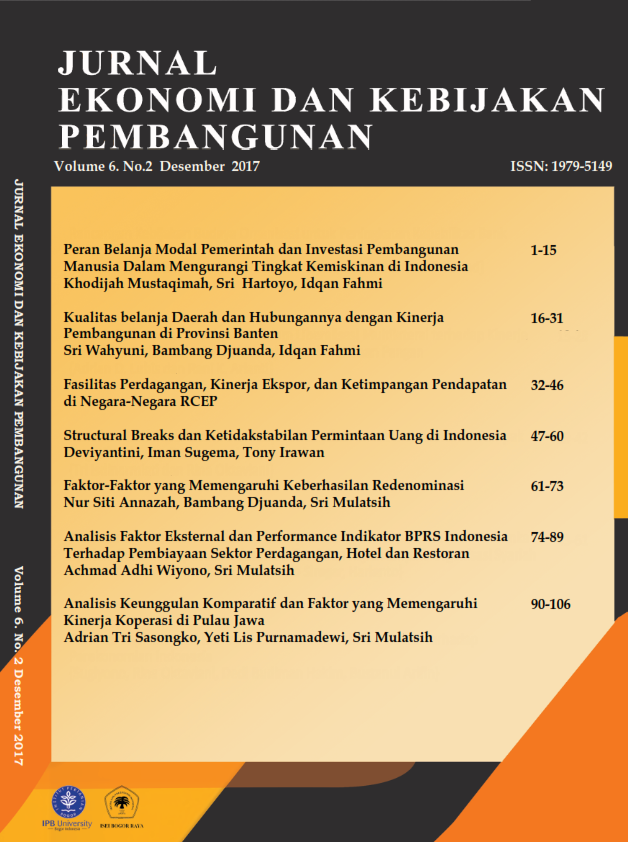PERAN BELANJA MODAL PEMERINTAH DAN INVESTASI PEMBANGUNAN MANUSIA DALAM MENGURANGI TINGKAT KEMISKINAN DI INDONESIA
Abstract
Poverty is a measure of socio-economic conditions in assessing the success of development undertaken by a government in a region. There are many negative impacts resulted from poverty, among others, social and economic problems. People who live in poverty usually suffer from malnutrition, poor health, high illiteracy rates, are in poor environment and in lack of access to infrastructure and adequate public services. The purpose of this study was to analyze the impact of human development and government capital expenditure on reducing poverty in Indonesia. The model was estimated by using 2SLS method. Several simulations was also conducted to look at the impact of the allocations of government expenditure on health, education and government capital expenditure on reducing poverty. The results showed that government capital expenditure and human development have significant impacts on reducing poverty in Indonesia with government expenditure on education gives the greatest impact.
Keywords: Capital, Expenditure, Government, Human Development, Poverty
References
Balisacan AM, Pernia EM, Asra A. 2003. Revisiting Growth and Poverty Reduction in Indonesia : What Do Subnational Data Show? . Bulletin of Indonesian Economic Studies, 39(3) : 329- 351.
Blankeanu WF, Simpson NB. 2004. Public Education Expenditures and Growth. Journal of Development Economcs, 73: 583-605.
Bidani B. dan Ravallion M. 1993. A Regional Poverty Profile for Indonesia. Bulletin of Indonesia and Economic Studies, 29 (3) : 37- 68.
Brata G . 2005. Investasi Sektor Publik Lokal, Pembangunan Manusia, dan Kemiskinan. Lembaga Penelitian – Universitas Atma Jaya Yogyakarta, Februari
Chemingui, Abdelbasset M. 2007. Public Spending and Poverty Reduction in an Oil based Economy: The Case of Yemen. Revised: January
Dagdeviren H, Hoeven R, Weeks J. 2002. Redistribution Does Matter: Growth and Redistribution for Poverty Reduction. WIDER Discussion Paper, No. 2002/05.
Eigbiremolen, Anaduaka. 2014. Human Capital Development and Economic Growth: The Nigeria Experience. International Journal of Academic Research in Business and Social Sciences. 4(4):12-14.
Fan S. 2000. How Does Public Spending Affect Growth and Poverty? The Experience of China. Paper submitted to 2nd annual Global Development Network Confrence. Tokyo, Japan.
Fane G, Warr P. 2002. How Economic Growth Reduces Poverty : A General Equilibrium Analysis for Indonesia. Discussion Paper No. 2002/9. United Nations University/ WIDER.
Gomanee, Karuna. 2003. Aid, Public Spending and Human Welfare: Evidence From Quantile Regressions, Paper for a Session on ‘Poverty and Human Development. Glasgow. 10-12 September
Hudaya, D. 2009. Faktor-faktor yang mempengaruhi tingkat kemiskinan di Indonesia. [skripsi]. Bogor (ID). Fakultas Ekonomi, Institut Pertanian Bogor.
Nanga M. 2006. Dampak Transfer Fiskal terhadap Kemiskinan di Indonesia: Suatu Analisis Simulasi Kebijakan. Disertasi Doktor. Sekolah Pascasarjana, Institut Pertanian Bogor, Bogor.
Putri SM. Yuliarmi NN. 2013. Beberapa Faktor yang Memengaruhi Tingkat Kemiskinan di Provinsi Bali. E-Jurnal EP Unud, 2(10):441- 448
Saputra WA. 2011. Analisis pengaruh jumlah penduduk, PDRB, IPM, pengangguran terhadap tingkat kemiskinan di kabupaten/kota Jawa Tengah. [skripsi]. Semarang (ID): Fakultas Ekonomi, Universitas Diponegoro.]
Sang Jung H dan Thorbecke E. 2001. The Impact of Public Education Expenditure on Human Capital, Growth, and Poverty in Tanzania and Zambia A General Equilibrium Approach. IMF Workng Paper 1(106):1-36
Subroto G. (2013). Peran Pendidikan Dalam Pertumbuhan Ekonomi Sektoral di Indonesia. Disertasi Doktor. Sekolah Pascasarjana, Institut Pertanian Bogor, Bogor.
Sulistyowati N. 2011. Dampak Investasi Sumber daya Manusia Terhadap Perekonomian dan Kesejahteraan Masyarakat di Jawa Tengah. Disertasi. Institut Pertanian Bogor: Sekolah Pascasarjana, Bogor.
Sumargo B, Yuniarty T. 2009. Model Persamaan Struktural Pembangunan Manusia dalam Kaitannya dengan Investasi Sektor Fisik, Manusia, Pendidikan, dan Kesehatan di Indonesia. Jurnal Mat Stat 9(2):108-117.
Sumarsono S. 2009. Teori dan Kebijakan Publik Ekonomi Sumber Daya Manusia. Yogyakarta (ID): Graha Ilmu.
Todaro MP, Smith SC. 2003. Pembangunan Ekonomi di Dunia Ketiga. Jakarta (ID): Erlangga.
Widodo A, Waridin, Maria J. 2011. Analisis Pengaruh Pengeluaran Pemerintah di Sektor Pendidikan dan Kesehatan Terhadap Pengentasan Kemiskinan Melalui Peningkatan Pembangunan Manusia di Provinsi Jawa Tengah. Jurnal Dinamika Ekonomi Pembangunan 1(1):25-42
Wiguna VI. 2013. Analisis Pengaruh PDRB, Pendidikan, Pengangguran terhadap Kemiskinan di Provinsi Jawa Tengah Tahun 2005-2010. Jurnal Ilmiah Mahasiswa FEB UB.
Yudhoyono SB. 2014. Pembangunan Pertanian dan Pedesaan Sebagai Upaya Mengatasi Kemiskinan dan Pengangguran: Analisa Ekonomi Politik dan Kebijakan Fiskal. [disertasi]. Semarang (ID): Fakultas Ekonomi, Institut Pertanian Bogor.
Authors

This work is licensed under a Creative Commons Attribution-NonCommercial-ShareAlike 4.0 International License.
The authors who publis article(s) in Jurnal Ekonomi and Kebijakan Pembangunan have to understand and agree that the copyright of article published is owned by Jurnal ekonomi and Kebijakan pembangunan including to reproduce, distribute and sell this journal to public.





